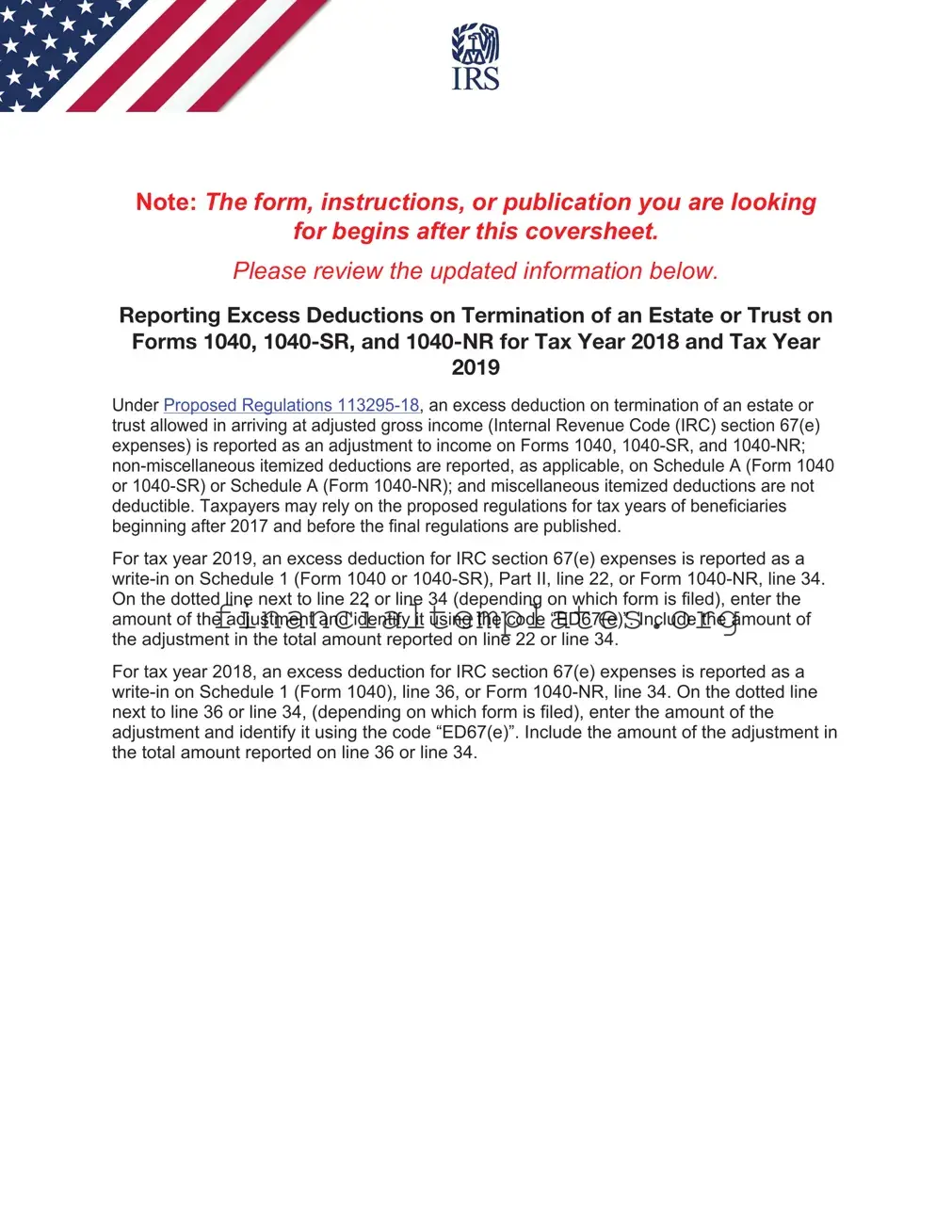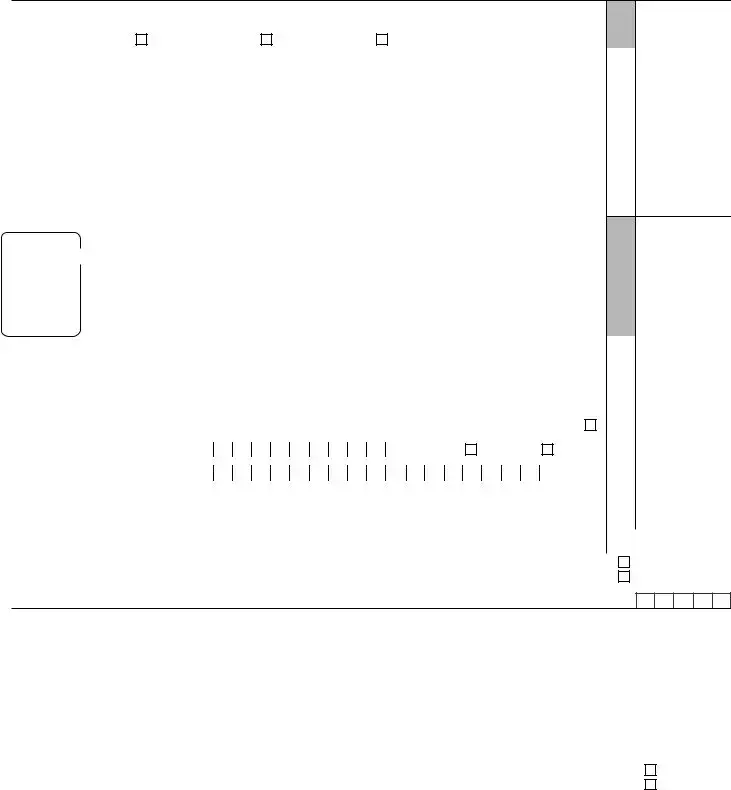Form 1040-SR (2021)Page 2
Standard |
|
|
|
|
|
|
|
|
|
|
12a |
Standard deduction or itemized deductions (from |
|
|
|
Deduction |
|
|
|
|
Schedule A) |
12a |
|
|
|
|
|
|
|
|
See Standard |
|
|
|
|
|
|
|
b |
Charitable contributions if you take the standard |
|
|
|
Deduction Chart |
|
|
|
|
|
on the last page |
|
|
|
deduction (see instructions) |
12b |
|
|
of this form. |
|
|
|
|
|
|
|
|
|
c |
Add lines 12a and 12b |
. . . . . . . 12c |
|
|
|
|
13Qualified business income deduction from Form 8995 or Form 8995-A . 13
14 Add lines 12c and 13 . . . . . . . . . . . . . . . . . . . . . 14
15Taxable income. Subtract line 14 from line 11. If zero or less, enter -0- . 15
16 Tax (see instructions). Check if any from: |
|
1 Form(s) 8814 2 Form 4972 3 |
. . . . . . . 16 |
17Amount from Schedule 2, line 3 . . . . . . . . . . . . . . . . . 17
18 Add lines 16 and 17 . . . . . . . . . . . . . . . . . . . . . 18
19Nonrefundable child tax credit or credit for other dependents from
Schedule 8812 . . . . . . . . . . . . . . . . . . . . . . . . 19
20Amount from Schedule 3, line 8 . . . . . . . . . . . . . . . . . 20
21 |
Add lines 19 and 20 |
21 |
22 |
Subtract line 21 from line 18. If zero or less, enter -0- |
22 |
23Other taxes, including self-employment tax, from Schedule 2, line 21 . . 23
24 Add lines 22 and 23. This is your total tax . . . . . . . . . . . ▶ 24
25Federal income tax withheld from:
|
|
|
|
a |
Form(s) W-2 |
. . . . |
. |
. |
. . |
|
25a |
|
|
|
|
|
|
|
b |
Form(s) 1099 |
. . . . |
. |
. |
. . |
|
25b |
|
|
|
|
|
|
|
c |
Other forms (see instructions) . . |
. . . . |
. |
. |
. . |
|
25c |
|
|
|
|
|
|
|
d |
Add lines 25a through 25c . . . |
. . . . |
. |
. |
. . |
. . . . . . . . |
|
25d |
|
|
26 |
|
2021 estimated tax payments and amount applied from 2020 return . . |
|
26 |
If you have |
|
|
|
|
|
|
|
|
|
|
|
|
27a |
|
|
27 |
a |
Earned income credit (EIC) . . . |
. . . . |
. |
. |
. . |
|
|
|
|
|
|
a qualifying |
|
|
|
|
child, attach |
|
|
|
Check here if you were born after January 1, 1998, |
|
|
|
|
|
Sch. EIC. |
|
|
|
and before January 2, 2004, and you satisfy all the |
|
|
|
|
|
|
|
|
|
|
|
|
|
|
|
|
|
|
|
|
other requirements for taxpayers who are at least |
|
|
|
|
|
|
|
|
|
|
age 18 to claim the EIC. See instructions . |
. |
. |
▶ |
|
|
|
|
|
|
|
|
|
b |
Nontaxable combat pay election . |
|
27b |
|
|
|
|
|
|
|
|
|
|
|
|
|
c |
Prior year (2019) earned income . |
|
27c |
|
|
|
|
|
|
|
|
|
28Refundable child tax credit or additional child tax
|
credit from Schedule 8812 |
|
28 |
|
|
29 |
American opportunity credit from Form 8863, line 8 . |
|
29 |
|
|
30 |
Recovery rebate credit. See instructions |
|
30 |
|
|
31 |
Amount from Schedule 3, line 15 |
|
31 |
|
|
32 |
Add lines 27a and 28 through 31. These are your total other payments |
|
|
and refundable credits |
. . . . . . . ▶ |
|
32 |
33 |
Add lines 25d, 26, and 32. These are your total payments . . . . . ▶ |
33 |
Go to www.irs.gov/Form1040SR for instructions and the latest information. |
|
|
|
Form 1040-SR (2021) |
Form 1040-SR (2021) |
|
|
|
|
|
|
|
Page 3 |
Refund |
34 |
If line 33 is more than line 24, subtract line 24 from line 33. This is the |
|
|
|
amount you overpaid . . . |
. . . . . . . . . . . . . . . |
. . . |
34 |
|
35a |
Amount of line 34 you want refunded to you. If Form 8888 is attached, |
|
|
|
check here |
. . . . . . . . . . . . . . . |
. ▶ |
35a |
Direct deposit? |
▶ b |
Routing number |
|
▶ c Type: |
Checking |
Savings |
|
See |
▶ d |
|
|
|
|
|
|
|
|
|
|
|
|
|
|
|
|
instructions. |
Account number |
|
|
|
|
|
|
|
36Amount of line 34 you want applied to your 2022
|
|
estimated tax |
. |
. |
. . |
▶ |
36 |
|
|
Amount |
37 |
Amount you owe. Subtract line 33 from line 24. For details on how to |
You Owe |
|
pay, see instructions |
. . . . . . . ▶ 37 |
|
38 |
Estimated tax penalty (see instructions) . |
. |
. |
. . |
▶ |
|
38 |
|
|
Third Party |
Do you want to allow another person to discuss this return with the IRS? See |
|
|
|
|
|
|
|
Designee |
instructions . . |
. . . . . . . . . . . . . . . . . . . ▶ |
Yes. Complete below. |
|
No |
|
Designee’s |
Phone |
Personal identification |
|
|
|
|
|
|
name ▶ |
no. ▶ |
number (PIN) |
▶ |
|
|
|
|
|
Sign
Here
Joint return? See instructions. Keep a copy for your records.
Under penalties of perjury, I declare that I have examined this return and accompanying schedules and statements, and to the best of my knowledge and belief, they are true, correct, and complete. Declaration of preparer (other than taxpayer) is based on all information of which preparer has any knowledge.
|
Your signature |
Date |
Your occupation |
If the IRS sent you an Identity |
▲ |
|
|
Protection PIN, enter it here |
|
|
|
|
(see inst.) |
|
|
|
|
|
|
|
|
|
|
|
|
|
|
|
|
|
|
|
Spouse’s signature. If a joint return, both must sign. |
Date |
Spouse’s occupation |
If the IRS sent your spouse an |
|
|
|
|
Identity Protection PIN, enter it here |
|
|
|
|
(see inst.) |
|
|
|
|
|
|
|
|
|
|
|
|
|
|
|
|
|
|
|
Phone no. |
Email address |
|
|
|
|
|
|
|
|
|
|
|
|
|
|
|
|
|
|
|
|
|
Paid |
Preparer’s name |
Preparer’s signature |
Date |
PTIN |
|
Check if: |
|
|
|
|
|
|
Self-employed |
Preparer |
|
|
|
|
|
|
Firm’s name ▶ |
|
|
|
Phone no. |
|
Use Only |
|
|
|
|
Firm’s address ▶ |
|
|
|
Firm’s EIN ▶ |
|
|
|
|
|
|
Go to www.irs.gov/Form1040SR for instructions and the latest information. |
|
|
Form 1040-SR (2021) |
Form 1040-SR (2021)Page 4
Standard Deduction Chart*
Add the number of boxes checked in the “Age/Blindness” section of Standard Deduction on page 1 . . . . ▶
IF your filing status is. . .
Single
Married filing jointly
Qualifying widow(er)
Head of household
Married filing separately**
AND the number of |
THEN your standard |
boxes checked is. . . |
deduction is. . . |
1 |
$14,250 |
2 |
15,950 |
1 |
$26,450 |
2 |
27,800 |
3 |
29,150 |
4 |
30,500 |
1 |
$26,450 |
2 |
27,800 |
1 |
$20,500 |
2 |
22,200 |
1 |
$13,900 |
2 |
15,250 |
3 |
16,600 |
4 |
17,950 |
*Don’t use this chart if someone can claim you (or your spouse if filing jointly) as a dependent, your spouse itemizes on a separate return, or you were a dual-status alien. Instead, see instructions.
**You can check the boxes for your spouse if your filing status is married filing separately and your spouse had no income, isn’t filing a return, and can’t be claimed as a dependent on another person’s return.
Go to www.irs.gov/Form1040SR for instructions and the latest information. |
Form 1040-SR (2021) |





